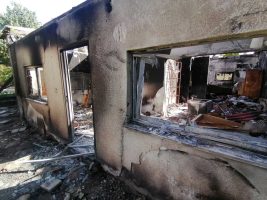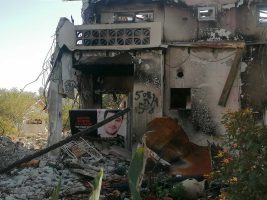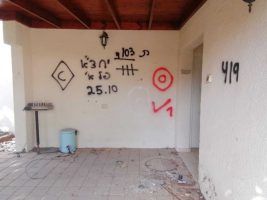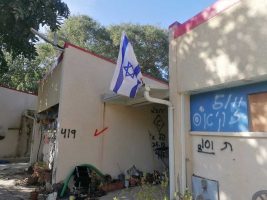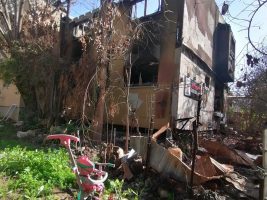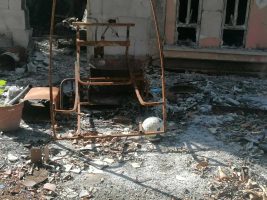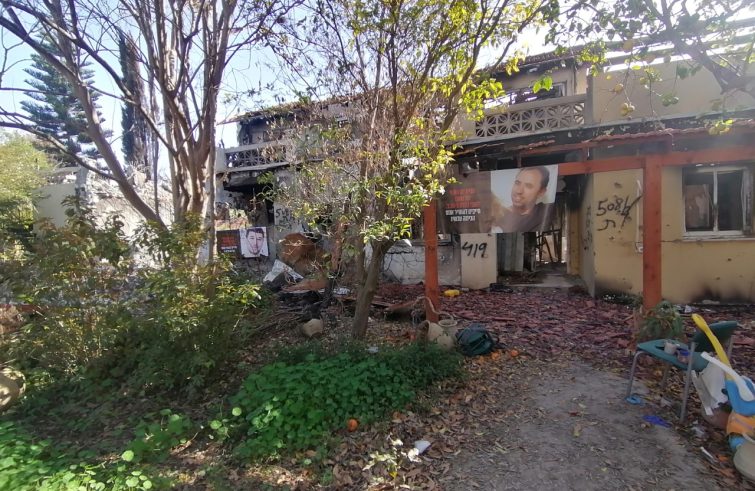
(From Be’eri) “I was locked in the ‘mamad’, the reinforced security room of the house (mandatory in every Israeli home, Ed.’s note), from Saturday afternoon until the evening of the next day, when the Israeli army arrived. We had no light, no water, no food. We fled with only what we were wearing. We stayed silent all the time to avoid being discovered by the terrorists. Our neighbours’ house was torched to the ground.”
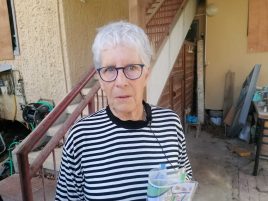 Nili Bar Sinai, 73 years old, 50 of which on this kibbutz that her husband Yoram, an architect, helped to plan, shows us a map of Be’eri, about 5 km from the Gaza border. She was a dedicated prison psychologist for years, and before the attack Nili worked in the kibbutz’s archives.
Nili Bar Sinai, 73 years old, 50 of which on this kibbutz that her husband Yoram, an architect, helped to plan, shows us a map of Be’eri, about 5 km from the Gaza border. She was a dedicated prison psychologist for years, and before the attack Nili worked in the kibbutz’s archives.
The Black Sabbath. As she walks, the woman retraces the early hours of 7 October 2023, when Hamas terrorists carried out a horrific attack on what everyone here has come to know as Israel’s “Black Sabbath”: 1,400 civilians massacred in several towns in southern Israel and 242 people taken hostage (to date, 136 are still in the hands of Hamas, Editor’s note). Be’eri, with a population of 1,200, was the scene of one of the most heinous massacres carried out by Hamas that day: 97 people were slaughtered, burned and mutilated, 30 were taken hostage and brought to Gaza, 20 have been released thanks to the agreement during the truce. Ten are still hostages, five of whom were killed in captivity. A third of the houses were torched, vandalised and destroyed. Her husband Yoram was among the dead. On the kibbutz, he is remembered as a man who loved Africa and was committed to rural development. In recent years he had devoted himself to planting trees to increase the kibbutz’s green areas. “Hamas terrorists entered the area while he was making coffee on the terrace and shot him dead,” Nili recalls.
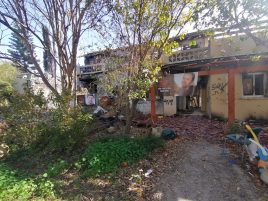 “They went from house to house, breaking down the doors and killing everyone inside, men, women, children, the elderly. Perhaps under the influence of drugs, they shouted and laughed as they slaughtered whoever they found”.
“They went from house to house, breaking down the doors and killing everyone inside, men, women, children, the elderly. Perhaps under the influence of drugs, they shouted and laughed as they slaughtered whoever they found”.
The slaughter. “In this house,” says the woman in a sombre tone of voice, “they exterminated an entire family, three generations, grandparents, children, grandchildren. Nili pauses before each devastated, smoke-blackened house, remembering those who lived there, in a sort of Spoon River of Be’eri: “Here on the kibbutz lived people who believed in peace, who did their best to help the people of Gaza, because so many came here to work. They provided for their families. They were all slaughtered, some burned alive beyond recognition. “The kibbutzniks, as the inhabitants of the kibbutz are called, tell us that it took days for the volunteers of Zaka – the Israeli paramedics organisation in charge of recovering every part of the remains of the dead – to give the corpses a face and a name. Posters bearing the faces of the victims or hostages held by Hamas have been hung on the walls of the bullet-riddled houses which remain standing. There are also signs and numbers painted on the walls by the Israeli army after ‘clearing’ the ground of mines and bombs left by the terrorists: “They signal that the house has been cleared. The numbers, however, indicate the victims found inside.” There are toys, burnt-out bicycles, prams, swings, dolls, footballs, tattered clothes, the remains of household appliances. In some places, we tread on the wreckage of houses, accompanied by the stench of smoke that is still lingering after more than three months.
- Kibbutz Be’eri (Foto Sir)
- Kibbutz Be’eri (Foto Sir)
- Kibbutz Be’eri (Foto Sir)
- Kibbutz Be’eri (Foto Sir)
- Kibbutz Be’eri (Foto Sir)
- Kibbutz Be’eri (Foto Sir)
Rebirth. These days, the kibbutz awaits the return of its residents, many of whom were evacuated to Tel Aviv and Dead Sea hotels in the immediate aftermath of the attack. Some people are unloading furniture from a lorry. Nili makes no secret of her concern that many will never return, but at the same time she is confident that ‘Be’eri will come back to life, even more beautiful than before. But first, security must be restored and what was destroyed must be rebuilt. Nili is certain of one thing:
“We will not be safe until Hamas is defeated.”
“My mother was killed in the first Palestinian terrorist attack on civilians in 1973 at what was then Lod airport (today’s Ben Gurion airport Ed.’s note). Fifty years on, we are still fighting. With all the funding Hamas receives from its backers, it could have given Gazans the best education, a better life, instead of building an underground city in Gaza and training children to kill. This is a doomed destiny. We need a political change, or we will have no hope for the future. But it will all depend on the women, the mothers, how they raise their children, how they educate them, whether to kill or to live together”, Nili concludes.

